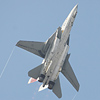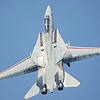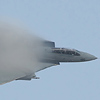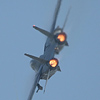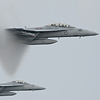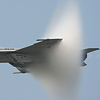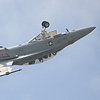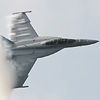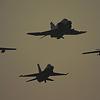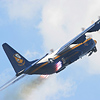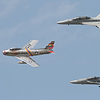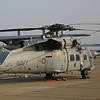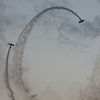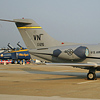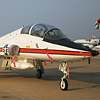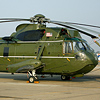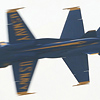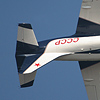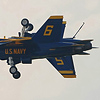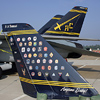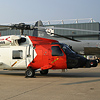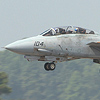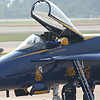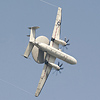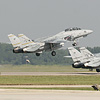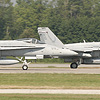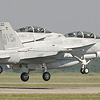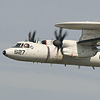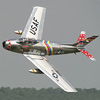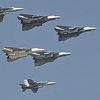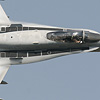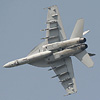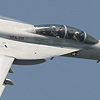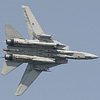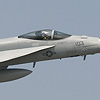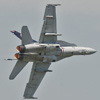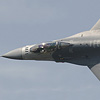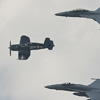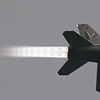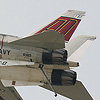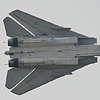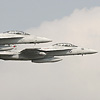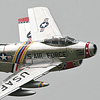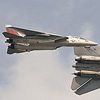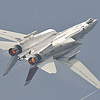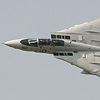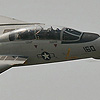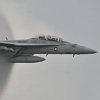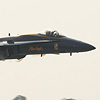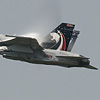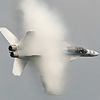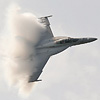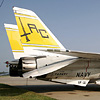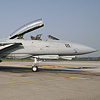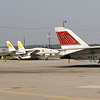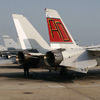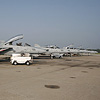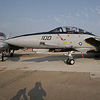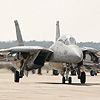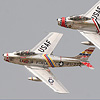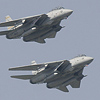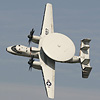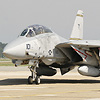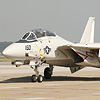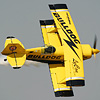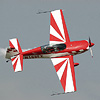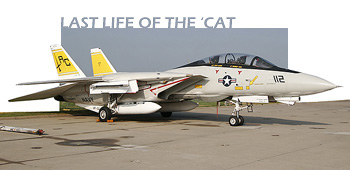
NAS Oceana Air Show 2005 Review
Friday 16th September - Sunday 18th September
After a long and remarkable career that spanned more than three decades, several major conflicts and a couple of blockbuster Hollywood releases, the winds of change have finally caught up with the F-14 Tomcat. A crowd favorite and an icon to a whole generation of enthusiasts, the 'Turkey' performed its last ever demonstration before the public at 2005 NAS Oceana airshow, and will be officially retired from active duty next year, after VF-213 and VF-31 return from their cruise on the USS Theodore Roosevelt. The UKAR Crew Team was there to witness the last moments of this wonderful war machine and to bring you the best of this remarkable show, which once again proved to be one of the world's top aviation events.
enjoyed one of the best weekends of his life at sunny and humid 'Honor, Pride, Tradition' 2005 NAS Oceana Air Show. Additional photography from .
After attending the 'In Pursuit of Liberty' 2004 NAS Oceana Airshow, I had more than enough reasons to believe that this year's event was one I couldn't miss, and surely it disappointed neither me nor the hordes of airshow enthusiasts that came from all over the globe to the USN's premier East Coast Master Jet Base. Although the Tomcat's inclusion in the flying displays was a late one, it didn't scare anyone from making plans to be at Oceana this September. That's hardly surprising, since this airshow is well known for providing year after year one of the most balanced and interesting line-ups of flying displays anywhere in the US, with heavy participation from both the USAF and the USN.
However, if there's one aspect where airshows at Oceana are a bit underwheliming, it has to be the static displays. This is something of a surprise for many, since Oceana is home to all remaining F-14 Tomcat, all East Coast F/A-18 Super Hornet, and 10 F/A-18 Hornet squadrons. But NAS Oceana does not own the aircraft based there (unlike USAF bases, which actually own theirs), and many squadrons didn't want to/ couldn't assign any personnel with the responsability of looking after their machines during the weekend. The major problem in 2005, however, was Hurricane Ophelia, whose forecast was predicting 35-40 knot winds (with gusts to 45 kts) with rain and thunderstorms from 1800 local time Wednesday until Thursday night at least. As a result, all aircraft on Oceana (more than 140) were ordered to be placed inside the hangars on Wednesday, making it impossible for the organizers on Friday to pull the jets they wanted to have on statics without pulling lots of others they didn't want to. Besides, the hurricane made many warbird owners reconsider their plans to bring their expensive aeroplanes to Oceana, which certainly didn't help matters. To top it off, all active USAF squadrons have cancelled support for all airshows for the time being, so only reserve USAF squadrons could be asked for static displays.
Not surprisingly, one couldn't find much to see on the tarmac. The only fighters on public display during the weekend were F-14B AC100 (VF-32's CAG Tomcat) and F/A-18E AD106 (from VFA-106) - a turnout less impressive than last year's, which included two F-14s and four F/A-18s, together with other USN machines like the E-2C and EA-6B, but no hurricane threat! The USAF did provide a few aircraft to help boost numbers, bringing in, among others, a B-52H, a C-5 and a C-21, and some really nice warbirds did turn up at Oceana after all, like the B-25 'Panchito', a PBY Catalina, and a Grumman TBF/M Avenger. Considering all the circunstances involved (including 45 mph winds early on Sunday, which caused 40 tents to be blown and demanded a lot of work to be done to have everything ready again when the gates were opened in the morning), Cdr. Rich 'Corky' Erie, the airshow organizer, and all Oceana volunteers did a superb job of making something out of nothing-hellip;
On the other hand, the aerial displays seen during the weekend were superb as always. The airshow actually started Friday morning with a full rehearsal of almost all aircraft that performed during the weekend. The gates, however, were opened to the public only during that afternoon, but to everyone's delight most aircraft flew again before dusk, including the F/A-18F Super Hornet, the F-86 Sabre duo, the F-16 Fighting Falcon, and the QF-4 Phantom. There were fewer twilight displays this year compared to 2004, but nonetheless those ones that were available were nice enough. If you have never seen C-130 'Fat Albert' perform a JATO take-off at night, you really have no idea how impressive it is. And Kent Shockley's 'Shockwave Jet Truck' (of which more later) can turn night into day with his three afterburners, which the public seems to love more than anything else at Oceana! A great fireworks show provided a colourful end to the twilight airshow, and it was time to head to the O' Club for some beer and lots of fun-hellip;
The weekend aerial displays started both days with Allen H. Smith's L-39C Albatros and Nancy Lynn's Extra 300. I had seen both perform earlier this year at JSOH, and all my impressions I expressed on that report apply to their performances at Oceana: Allen's a great pilot with an impressive résumé, but he badly needs a new engine for his Albatros (he was quoted at Andrews saying that he was planning to replace his current one with a more powerful L-159 turbofan). His routine is still a slow-paced and predicable one, and people hardly stopped doing other things to look up to the sky. Nancy's display, on the other hand, is quite a good one, although her son repeated ad nauseam on Saturday that it was her mom in the cockpit. It's great PR and I find really nice to see such family connections in an airshow, but it detracted a little bit from her performance that day. On Sunday he didn't do the same, and I was able to enjoy much more.
The next performance was provided by a USN E-2C Hawkeye from VAW-120 'Greyhawks', flown by Lt. Charles Choate, Lt. Justin Steenson, Lt. Scott Wastak and Lt. Ken Pierce during the weekend. VAW-120 is the sole fleet replacement squadron (FRS) for the E-2C since 1994 (when VAW-110 was decommissioned), and it is tasked with the training of all new Hawkeye crewmembers. The aircraft flown during the weekend (#624 and #627) were the upgraded Hawkeye 2000 variants, which have a new mission computer, a new data loader recorder, and the new (and more easily noticeable) all-composite NP-2000 eight-bladed propeller. Once more, I was impressed to see how nimble such a seemingly heavily-loaded E-2C can be, a tribute not only to Grumman engineers but also to the pilots who flew two spiritedly displays over the weekend.
Following the E-2C on Saturday, Dale Snodgrass' F-86 low-level, high-energy display proved one more why his F-86 performance is hands down the premier Sabre act anywhere in the world. His opening pass fails to impress no one, even those who have seen it time after time. It's not an exaggeration to say it's close enough to scare even the most seasoned pilot, but it seems to be a straightforward maneuver for Mr. Snodgrass. Better known in some circles as the pilot with the most flying hours in the F-14 Tomcat, 'Snort's Sabre act could only be bettered by himself later that day, when he flew together with Ed Shipley in a breathtaking Sabre duo performance. If you knew nothing about it, you'd swear they're doing this for years, but actually it was the first time they've ever flown together in an airshow with F-86s. This was one of the true special moments of this years' airshow, and hopefully these great men will continue to perform together for many years to come.
After the parachute teams (and there were three of them: US Army's Black Daggers, Canadian Skyhawks, and the British Red Devils) performed their first jump, it was time to see what Oceana is is all about: Tomcats and Hornets. The Fleet Fly-by and the USN Airpower Demo are what tells Oceana apart from all other airshows in the US - nowhere else one can see so many tactical aircraft in the air at the same time. This year, the Fleet Fly-by was flown by four F-14s from VF-32 'Swordsmen', two F/A-18Fs from VFA-211 'Checkmates' (a third from VFA-106 'Gladiators' took part in the Airpower Demo), and two F/A-18Cs from VFA-136 'Knighthawks'. On Saturday the full ground attack performance was performed, but on Sunday some low clouds prevented that, and all the high bombing passes were scrapped. Instead, lots of high-G turns were performed, providing photographers something which has become an Oceana trademark: vapour shots! It doesn't get much better than what we had there this year, believe me…
Moments after recovering the many F-14s and F/A-18s involved in the displays mentioned above, more F/A-18s were scrambled, but these were from a different model from those mentioned above. VFA-143 'Pukin' Dogs', which has just recently finished its conversion to Super Hornets, took off with their F/A-18Es to refine their carrier landing techniques aboard the USS John F. Kennedy (CVN-67), which was steaming off the coast. The Skytypers and their T-6s were next, followed by Kent Shockley's highly modified 'Shockwave Jet Truck'. A heavily-modified Peterbilt powered by no less than three Pratt & Whitney J34-48 (the same engine used in the T-2C Buckeye), it can accelerate up to more than 350mph, although Oceana's runways weren't long enough from him to achieve such high speed. On Sunday only, Kent was followed by Gene Soucy, Teresa Stokes and the Showcat. This is one of the longest active wing walking acts in the US, and both Gene and Teresa haven't lost their edge. It's always nice to see Gene in the air, especially at night, so it was unfortunate that he managed to turn up only on Sunday.
One of the nice surprises of the airshow this year was the much-improved USN F/A-18C demo, performed this year by the East Coast Demo Team's Lt. Joe 'Pokey' Alden flying VFA-131's CAG F/A-18C AG400. The USN F/A-18C Hornet display was in the past far inferior to what we're used to see from Switzerland and Finland, but not anymore. A healthy number of high alpha maneuvers and lots of afterburner have brought its display closer to the ones performed by its newer brother, the F/A-18F Super Hornet. It also helped to have the beautifully schemed CAG Hornet from VFA-131 'Wildcats' this time instead of a regular bird from the squadron currently tasked with providing this demo, the VFA-106 'Gladiators'.
The Showcopters and their Robinson R44 and R22 helicopters flew after the 'baby' Hornet was done for the day. Led by Jim Cheatham, this is the only helicopter team in the US, and they had to come all the way from Salinas, California. They were immediately followed by Jim LeRoy and his bright yellow 'Bulldog' Pitts S2S. Jim is a former Marine Scout/Sniper who can perform every maneuver one can think of with his Pitts, and has improved his act year after year. On Sunday only, Jim, Gene Soucy and Kent Shockley joined forces to form the X-Team, which has all three performing together to create lots of action and havoc in the display box. This performance was supposed to be a tribute to their fellow comrades Jimmy Franklin and Bob Younkin, who lost their lives earlier this year at the Saskatchewan Airshow, and it was a pretty good one. Hopefully the new 'Masters of X-treme' will continue this great act and, with it, help perpetuate the great legacy left by the two aforementioned airshow greats.
The USAF was also represented at 2005 Oceana Airshow with an F-16C and the superb QF-4 Phantom. The 20th FW F-16C Fighting Falcon or “Viper' display from Shaw AFB, flown this year by Maj. Geoff 'Hak' Hickman of the Viper East Coast Demo team, took off together with the QF-4 and the two F-86 Sabres, but was the first to perform. Once more, this was a display that was improved compared to the ones seen in years before, but in this case it's still underwhelming compared to what the Belgians and especially the Dutch can do with the F-16. This is probably the most difficult demo to get good pictures from, because the Viper's a small aircraft that flies most times a little bit away from the crowd line, and the USAF is definitely accurate when it points out to the fact the Viper's current scheme make it harder to be seen during the day - my 20D seems to concur wholeheartedly, having had once more a hard time achieving the correct focus during its display!
The opposite thing happened during the USAF Heritage Flight that followed the F-16C, perfect focus being obtained during all three passes that were performed. In the lead this time was Lt. Col. Jerry Kerby and his beautiful Vietnam-era camouflaged QF-4 Phantom from Tyndall AFB. I'd seen this jet at JSOH earlier this year, but it didn't fly there because it was the spare machine. Since the grey Phantom that did fly at JSOH never made it to Oceana, this colourful QF-4 was the one that flew with the F-16 and the two F-86s, and it was by far and away the best heritage flight during the weekend. The USN also had its Tailhook Legacy Flight in the air both days, but the F/A-18C Hornet, F/A-18F Super Hornet, and the F4U Corsair (an F-86 Sabre masquerading as a FJ Fury on Sunday, since the Corsair went tech) that took part in it flew a much looser formation. It's probably the only display these days where the USAF has a clear advantage over the USN, since the single-ship USN demos are IMHO better than their USAF counterparts.
One display which the USN has no equal, on the other hand, is the one provided by the always welcome B-2 Spirit stealth bomber, which unfortunately was performed only on Saturday. Perhaps scared by so many foreigners on the ground, the B-2 performed two very tame turns, and disappeared after just a couple minutes in the air. The Red Baron Pizza Squadron and their Stearman biplanes were next on Saturday, and lots of noise and smoke accompanied them during their whole performance. I quite enjoy their maneuvers, and really like listening to those big old 'round' engines screaming in the sky. The two remaining solo displays, the F/A-18F Super Hornet and the final F-14 Tomcat demos ever, were the two best ones of the airshow. The Super Hornet or 'Rhino' demo, flown during the weekend by Lt. Sean 'Knuckles' Price, Lt. Charles 'Ox' Shamonsky, Lt. Ian 'Goon' Burgoon and Lt. Craig 'Spank' Sidwell from VFA-106, is the best fighter display anywhere in the western hemisphere. This time, however, it was completely eclipsed by the demonstration performed by its predecessor, the F-14 Tomcat. It was, of course, the last time ever the public saw a F-14 perform before their eyes, but I still maintain the main reason for the Tomcat's stealing the show was that the Rhino lacks the 'Cat's grace and good looks in the air and on the ground. Just compare the number of shots posted on the internet after the show - which one has the clear advantage?
Anyway, Lt. Jack 'Rocco' Tangredi and Lt. Joseph 'Smokin' Joe' Ruzicka (wearing special Oakley visors) made history flying VF-32's F-14 AC104 on Saturday and the beautiful retro schemed VF-101's F-14 AD160 on Sunday, and at 2:52 PM local time an icon had reached the end of its airshow life. Of course the airshow was not over yet, with Fat Albert and the Blue Angels providing a very nice curtain call (the Blues, it must be said, flew one of the tightest and more impressive displays I've ever seen them perform - really superb), but the Tomcat was the main story this year. I have to confess I had a few tears in my eyes when it rolled past me after its display, because I never thought I'd witness the farewell of my favorite aircraft. Like a close friend that passed away, the Tomcat's departure left a void in the heart, one that hopefully will be filled by other fighters in the future. In the meantime, the memories - and there are plenty - will have to do the job…
In short, the 2005 NAS Oceana Airshow was everything I'd expected it to be and much more. Last year, I wrote everybody should try to make this year's airshow, because it was going to be a good one, and it was. So what are you waiting to start making plans to attend next year? It's money well spent, and I'm sure you will never regret going there.

